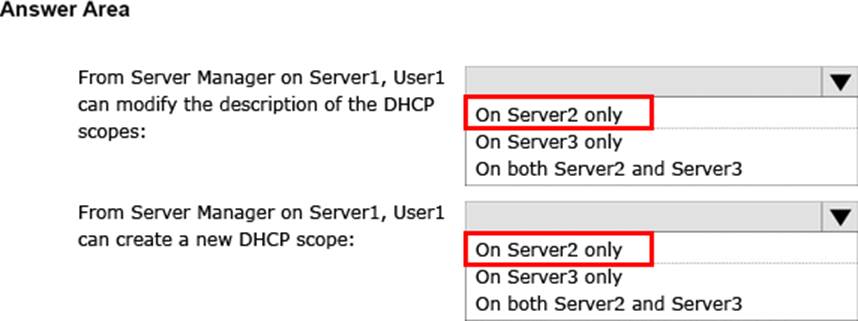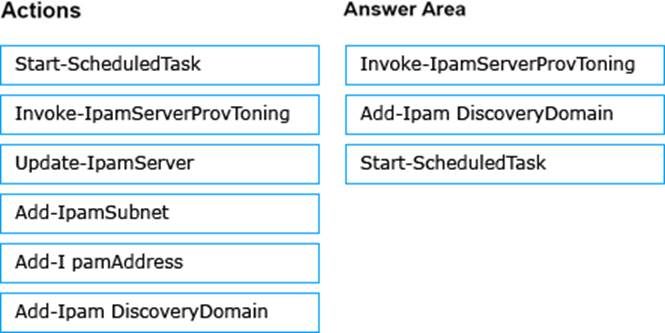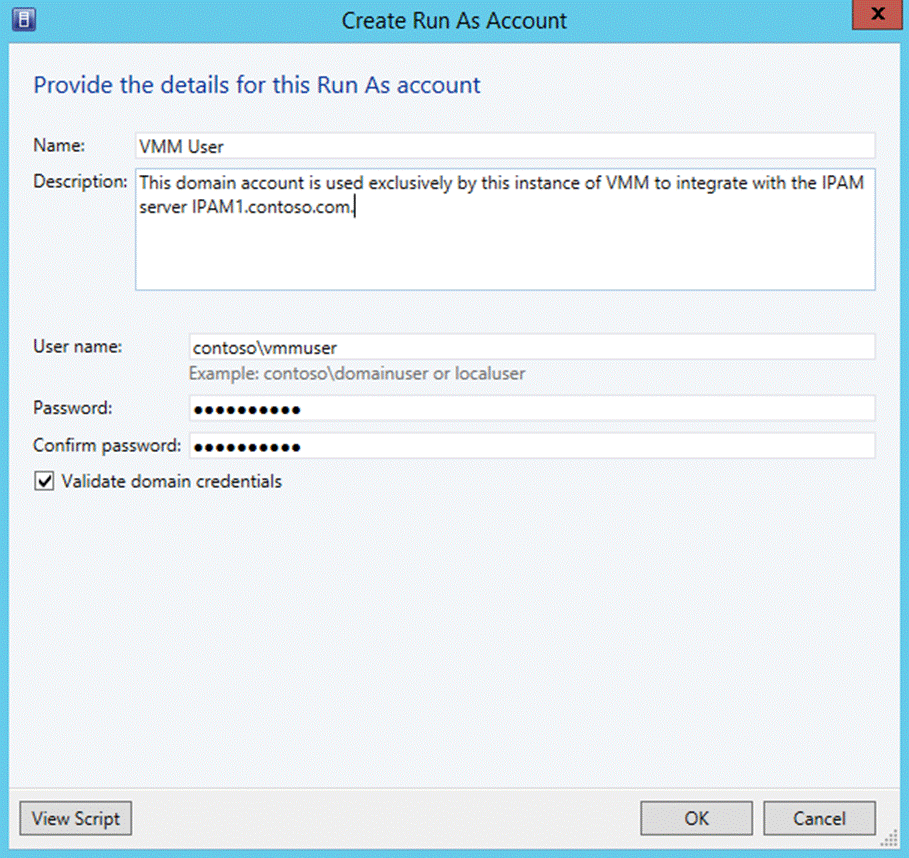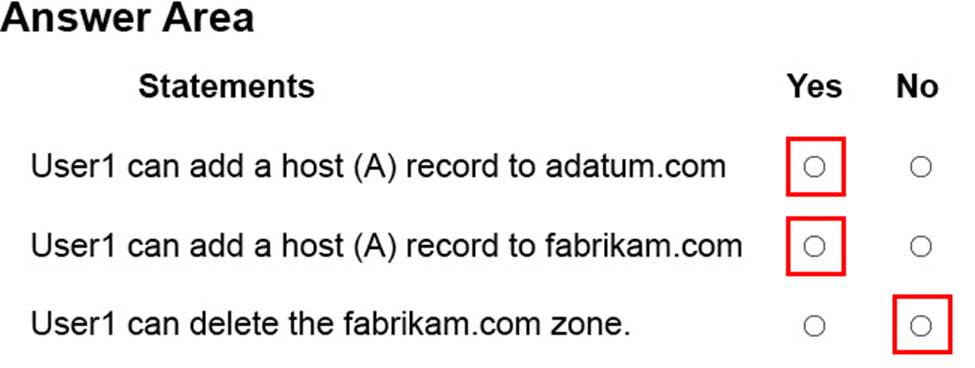Microsoft 70-743 Microsoft Upgrading Your Skills to MCSA: Windows Server 2016 Online Training
Microsoft 70-743 Online Training
The questions for 70-743 were last updated at Jan 21,2025.
- Exam Code: 70-743
- Exam Name: Microsoft Upgrading Your Skills to MCSA: Windows Server 2016
- Certification Provider: Microsoft
- Latest update: Jan 21,2025
Note: This question is part of a series of questions that use the same or similar answer choices. An answer choice may be correct for more than one question in the series. Each question is independent of the other questions in this series. Information and details provided in a question apply only to that question.
You have a Hyper-V host named Server1 that runs Windows Server 2016. Server1 contains a virtual machine named VM1.
You need to ensure that you can use nested virtualization on VM1.
What should you run on Server1?
- A . the Mount-VHD cmdlet
- B . the Diskpart command
- C . the Set-VHD cmdlet
- D . the Set-VMcmdlet
- E . the Set-VMHost cmdlet
- F . theSet-VMProcessor cmdlet
- G . the Install-WindowsFeature cmdlet
- H . the Optimize-VHD cmdlet
Note: This question is part of a series of questions that use the same or similar answer choices. An answer choice may be correct for more than one question in the series. Each question is independent of the other questions in this series. Information and details provided in a question apply only to that question.
You have a Hyper-V host named Server1 that runs Windows Server 2016. Server1 has a dynamically expanding virtual hard disk (VHD) file that is 900 GB. The VHD contains 400 GB of free space.
You need to reduce the amount of disk space used by the VHD.
What should you run?
- A . the Mount-VHD cmdlet
- B . the Diskpart command
- C . the Set-VHD cmdlet
- D . the Set-VM cmdlet
- E . the Set-VMHost cmdlet
- F . the Set-VMProcessor cmdlet
- G . the Install-WindowsFeature cmdlet
- H . the Optimize-VHD cmdlet
You have a Hyper-V host named Server1 that runs Windows Server 2016. Server1 hosts a virtual machine named VM1. You need to provide VM1 with direct access to a graphics processing unit (GPU) on Server1.
What should you do first?
- A . OnVM1, install the Quality Windows Audio Video Experience (qWave) feature.
- B . Disable the display adapter device on Server1.
- C . In the settings of VM1, add a RemoteFX 3D Video Adapter.
- D . Dismount the display adapter on Server1.
HOTSPOT
Your network contains an Active Directory domain named contoso.com. The domain contains three servers named Server1, Server2, and Server3 that run Windows Server 2016.
Server1 has IP Address Management (IPAM) installed. Server2 and Server3 have the DHCP Server role installed and have several DHCP scopes configured. The IPAM server retrieves data from Server2 and Server3.
A domain user named User1 is a member of the groups shown in the following table.

On Server1, you create a security policy for User1. The policy grants the IPAM DHCP Scope Administrator Role with the Global access scope to the user.
Which actions can User1 perform? To answer, select the appropriate options in the answer area.
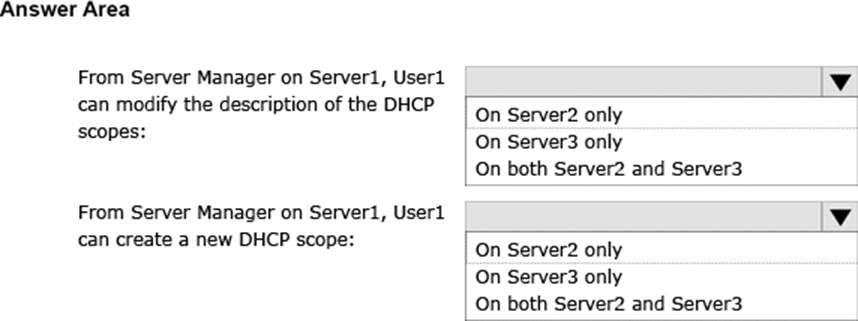
You have two Hyper-V hosts named Server1 and Server2 that run Windows Server 2016.
The following virtual switches are configured on the Hyper-V hosts.

The following virtual machines run on the Hyper-V hosts.
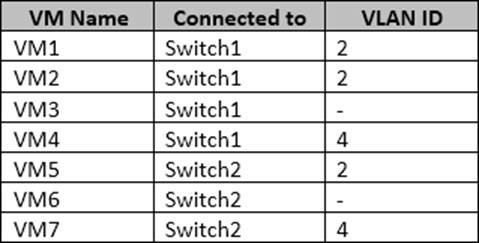
All virtual machines have IP addresses from the 192.168.1.0/24 network. VLANs are configured in Hyper-V only. Physical switches are not configured with VLANs.
To which virtual machine or virtual machines can VM1 connect?
- A . VM2, VM3, VM5 and VM6 only
- B . VM2, VM3 and VM4 only
- C . VM2 only
- D . VM2 and VM5 only
DRAG DROP
Your network contains an Active Directory domain named contoso.com. The domain contains a server named Server1 that runs Windows Server 2016.
You install IP Address Management (IPAM) on Server1. You need to manually start discovery of servers that IPAM can manage in contoso.com.
Which three cmdlets should you run in sequence? To answer, move the appropriate cmdlets from the list of cmdlets to the answer area and arrange them in the correct order.
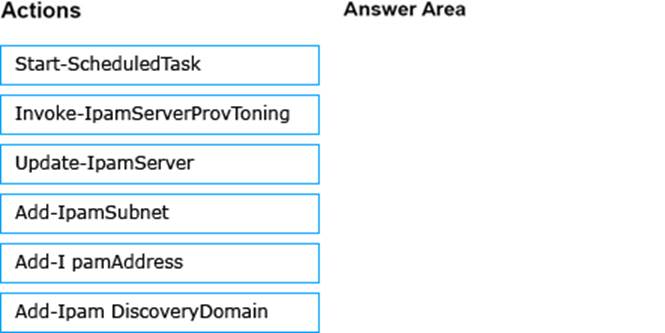
You have an Active Directory domain named contoso.com.
The computers in contoso.com are installed by using Windows Deployment Services. You have a server named Server1 that runs Windows Server 2016. Server1 is a member of contoso.com. Server1 has the Hyper-V role installed. Virtual machines on Server1 are connected to an external switch named Switch1.
You create a virtual machine named VM1 on Server1 by running the following cmdlets.
![]()
You need to ensure that you can install the operating system on VM1 by using Windows Deployment Services.
What should you do?
- A . Add a legacy network adapter to VM1.
- B . Modify the SwitchType parameter of Switch1.
- C . Modify the DefaultFlowMinimumBandwidthWeigth parameter of Switch1.
- D . Add a SCSI controller to VM1.
Your network contains an Active Directory domain named contoso.com. The domain contains a server named Server1 that runs Windows Server 2016.
Server1 has IP Address Management (IPAM) installed. IPAM is configured to use the Group Policy based provisioning method. The prefix for the IPAM Group Policy objects (GPOs) is IP.
From Group Policy Management, you manually rename the IPAM GPOs to have a prefix of IPAM.
You need to modify the GPO prefix used by IPAM.
What should you do?
- A . Click Configure server discovery in Server Manager.
- B . Run the Set-IpamConfiguration cmdlet.
- C . Run the Invoke-IpamGpoProvisioning cmdlet.
- D . Click Provision the IPAM server in Server Manager.
DRAG DROP
Your network contains an Active Directory domain named contoso.com. The domain contains two servers named Server1 and Server2 that run Windows Server 2016.
Server1 has IP Address Management (IPAM) installed. Server2 has Microsoft System Center 2016 Virtual Machine Manager (VMM) installed.
You need to integrate IPAM and VMM.
Which types of objects should you create on each server? To answer, drag the appropriate object types to the correct servers. Each object type may be used once, more than once, or not at all. You may need to drag the split bar between panes or scroll to view content.

HOTSPOT
Your network contains an Active Directory domain named contoso.com. The domain contains a domain controller named Server1 and a member server named Server2.
Server1 has the DNS Server role installed. Server2 has IP Address Management (IPAM) installed.
The IPAM server retrieves zones from Server1 as shown in the following table.

The IPAM server has one access policy configured as shown in the exhibit. (Click the Exhibit button.)
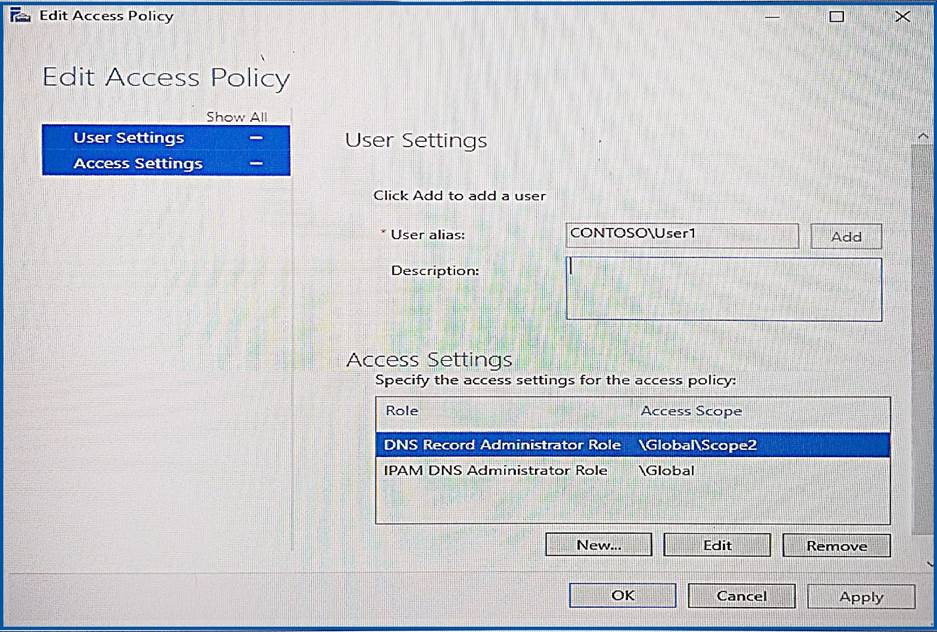
For each of the following statements, select Yes if the statement is true. Otherwise, select No.
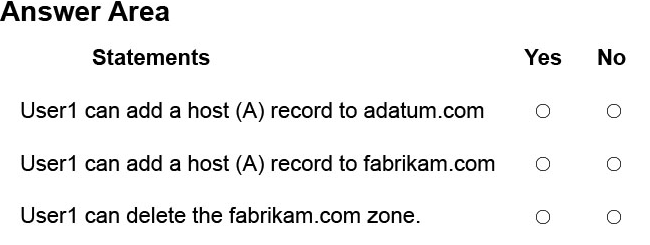
Latest 70-743 Dumps Valid Version with 252 Q&As
Latest And Valid Q&A | Instant Download | Once Fail, Full Refund

